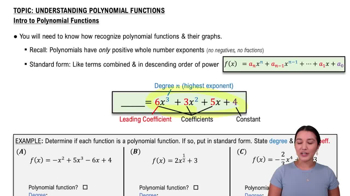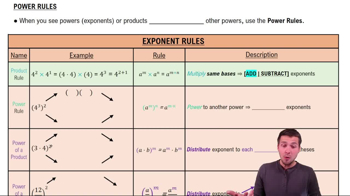Table of contents
- 0. Functions7h 52m
- Introduction to Functions16m
- Piecewise Functions10m
- Properties of Functions9m
- Common Functions1h 8m
- Transformations5m
- Combining Functions27m
- Exponent rules32m
- Exponential Functions28m
- Logarithmic Functions24m
- Properties of Logarithms34m
- Exponential & Logarithmic Equations35m
- Introduction to Trigonometric Functions38m
- Graphs of Trigonometric Functions44m
- Trigonometric Identities47m
- Inverse Trigonometric Functions48m
- 1. Limits and Continuity2h 2m
- 2. Intro to Derivatives1h 33m
- 3. Techniques of Differentiation3h 18m
- 4. Applications of Derivatives2h 38m
- 5. Graphical Applications of Derivatives6h 2m
- 6. Derivatives of Inverse, Exponential, & Logarithmic Functions2h 37m
- 7. Antiderivatives & Indefinite Integrals1h 26m
1. Limits and Continuity
Finding Limits Algebraically
Problem 103
Textbook Question
Find constants b and c in the polynomial p(x)=x^2+bx+c such that lim x→2 p(x) / x−2=6. Are the constants unique?
 Verified step by step guidance
Verified step by step guidance1
Step 1: Recognize that the limit \( \lim_{x \to 2} \frac{p(x)}{x-2} = 6 \) implies that \( x-2 \) is a factor of \( p(x) \). Therefore, \( p(x) \) can be expressed as \( (x-2)(x-a) \) for some constant \( a \).
Step 2: Expand \( p(x) = (x-2)(x-a) = x^2 - (a+2)x + 2a \).
Step 3: Compare the expanded form \( x^2 - (a+2)x + 2a \) with the original polynomial \( x^2 + bx + c \). This gives the equations: \( b = -(a+2) \) and \( c = 2a \).
Step 4: Use the given limit condition \( \lim_{x \to 2} \frac{p(x)}{x-2} = 6 \). Substitute \( x = 2 \) into the factorized form \( (x-2)(x-a) \) to find \( 2-a = 6 \), which gives \( a = -4 \).
Step 5: Substitute \( a = -4 \) into the equations \( b = -(a+2) \) and \( c = 2a \) to find the values of \( b \) and \( c \). Check if these values are unique by considering the factorization and the limit condition.
Recommended similar problem, with video answer:
 Verified Solution
Verified SolutionThis video solution was recommended by our tutors as helpful for the problem above
Video duration:
7mPlay a video:
Was this helpful?
Key Concepts
Here are the essential concepts you must grasp in order to answer the question correctly.
Limits
A limit is a fundamental concept in calculus that describes the behavior of a function as its input approaches a certain value. In this question, we are interested in the limit of the polynomial p(x) as x approaches 2, specifically how it behaves in relation to the expression (x - 2). Understanding limits is crucial for evaluating the continuity and differentiability of functions.
Recommended video:

One-Sided Limits
Polynomial Functions
A polynomial function is a mathematical expression involving a sum of powers in one or more variables multiplied by coefficients. In this case, p(x) = x^2 + bx + c is a quadratic polynomial. Recognizing the structure of polynomial functions helps in analyzing their limits and determining the values of coefficients that satisfy specific conditions.
Recommended video:

Introduction to Polynomial Functions
L'Hôpital's Rule
L'Hôpital's Rule is a method used to evaluate limits of indeterminate forms, such as 0/0 or ∞/∞. When applying this rule, one differentiates the numerator and denominator until the limit can be resolved. In this problem, if substituting x = 2 results in an indeterminate form, L'Hôpital's Rule may be necessary to find the constants b and c that satisfy the limit condition.
Recommended video:
Guided course

Power Rules

 5:21m
5:21mWatch next
Master Finding Limits by Direct Substitution with a bite sized video explanation from Callie
Start learningRelated Videos
Related Practice







